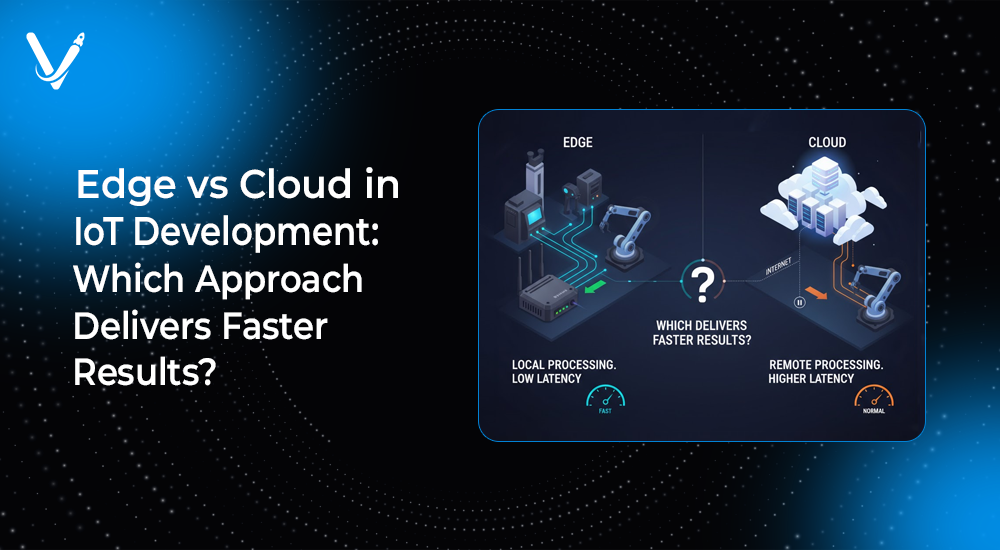Edge vs Cloud in IoT Development: Which Approach Delivers Faster Results?


- Oct 30, 2025



Key Takeaways
In today’s hyperconnected industrial landscape, enterprises are racing to harness the full potential of the Internet of Things (IoT). Factories, logistics networks, energy systems, and smart infrastructure now rely on interconnected sensors and devices generating immense volumes of real-time data. Yet, as this data flood grows, one question dominates the conversation: Where should the data be processed — at the Edge or in the Cloud?
The debate between Edge vs Cloud computing in IoT development has become central to enterprise digital transformation. Both paradigms power data-driven intelligence but approach it differently. Edge computing pushes computation closer to the data source — at gateways, machines, or devices — enabling rapid response times and autonomy. Cloud computing, on the other hand, centralizes data storage and analysis in large data centers, providing massive scalability, advanced analytics, and long-term insights.
Enterprises today face a tough decision. Should they rely on the agility of the Edge for instant decision-making, or on the power of the Cloud for deep analytics and scalability? The answer isn’t binary. Each approach delivers unique value, and choosing the right one requires a strategic understanding of how IoT systems function, what data matters most, and how quickly decisions need to be made.
This article dives deep into Edge vs Cloud in enterprise IoT development, exploring how each impacts data processing speed, system scalability, security, cost, and return on investment. It also uncovers why many forward-thinking enterprises are embracing a hybrid model to combine the best of both worlds.
Data is the lifeblood of IoT. Sensors embedded across machines, vehicles, and supply chains generate continuous streams of information — temperature, vibration, energy consumption, pressure, and countless other metrics. These data points enable enterprises to optimize operations, predict equipment failures, and make data-driven decisions.
However, IoT data comes with challenges: it is massive, continuous, and time-sensitive. For instance, a single industrial plant might generate terabytes of sensor data daily. Sending all of this raw data to the Cloud for analysis introduces latency, bandwidth costs, and potential downtime. That’s where Edge computing steps in, enabling localized processing to reduce reliance on centralized systems.
But the Cloud still plays a crucial role in aggregating, analyzing, and learning from large datasets across time and geography. It’s what enables predictive maintenance algorithms, AI-driven optimization, and global IoT orchestration.
Thus, the question is not just about where data should live, but where and how it should be processed for maximum efficiency and speed.
Edge computing in IoT means processing data near the source — at gateways, routers, or directly on IoT devices — instead of sending everything to a distant Cloud server. By keeping computation close to the data origin, Edge computing minimizes latency and improves response times.
In enterprise IoT, Edge nodes can exist inside factories, power plants, vehicles, or warehouse floors. They handle real-time tasks such as equipment monitoring, anomaly detection, or process control without relying on an external connection.
For example, in a smart manufacturing facility, sensors on production lines can detect an equipment malfunction and trigger an instant shutdown to prevent damage. This decision must happen in milliseconds — too fast for Cloud processing dependent on internet connectivity. That’s where Edge computing shines.
In essence, Edge computing transforms IoT devices from passive data collectors into intelligent agents capable of acting instantly.
Cloud computing in IoT development refers to storing and analyzing data in large, centralized data centers managed by service providers such as AWS, Microsoft Azure, or Google Cloud. These environments offer vast computational power, data redundancy, and global accessibility.
In an enterprise IoT context, the Cloud serves as the central nervous system, integrating data from multiple Edge locations to identify long-term trends, train AI models, and coordinate large-scale operations.
For example, while an Edge gateway might analyze vibration data to detect anomalies in a single machine, the Cloud can aggregate years of data from multiple factories to predict broader patterns, optimize resource allocation, and enhance system design.
Cloud computing essentially provides the macro perspective — the big-picture analysis that drives enterprise-wide intelligence.
While both Edge and Cloud computing power IoT ecosystems, their processing philosophy, architecture, and impact differ fundamentally.
| Aspect | Edge Computing | Cloud Computing |
| Location of Processing | Near or at the data source | Centralized remote data centers |
| Latency | Extremely low | Higher due to data transmission |
| Connectivity Dependency | Operates even offline | Requires stable network access |
| Scalability | Limited by local hardware | Virtually unlimited |
| Data Security | Localized, reduces external exposure | Dependent on provider’s security |
| Use Cases | Real-time control, automation, predictive maintenance | Analytics, forecasting, global management |
Edge computing focuses on speed and autonomy, while Cloud computing focuses on scalability and intelligence. Most modern enterprises need both — fast decision-making at the Edge and strategic insights in the Cloud.
Speed defines the success of IoT systems. In industries like manufacturing, energy, and logistics, milliseconds can determine efficiency, safety, and profitability. A delay in detecting an equipment anomaly or responding to a hazard can lead to production losses or downtime.
Edge computing provides this speed advantage by processing information instantly where it’s generated. When a sensor detects an irregular vibration in a turbine, Edge analytics can trigger immediate intervention, avoiding catastrophic failure. In contrast, if that data had to travel to a Cloud server for analysis, valuable seconds could be lost.
However, not every IoT task demands instant results. Predicting long-term maintenance schedules or optimizing supply chain routes relies on historical and large-scale data analytics, which the Cloud handles better.
Therefore, enterprises must evaluate the time-sensitivity of their IoT operations to decide where computation should occur.
Factories use Edge computing to monitor and control robotic systems in real time. Edge analytics can instantly detect torque deviations or alignment errors and halt the machine to prevent waste. Meanwhile, Cloud systems analyze aggregated data across all factory lines to improve design and efficiency.
Power grids rely on Edge nodes to manage voltage fluctuations and prevent outages. Cloud platforms analyze consumption patterns and forecast energy demands across regions, ensuring optimized resource distribution.
Edge computing in connected vehicles enables real-time route optimization and collision avoidance. Cloud computing centralizes fleet data to generate operational insights, fuel efficiency metrics, and predictive maintenance alerts.
Remote drilling sites use Edge analytics for safety and environmental monitoring, ensuring instant alerts for gas leaks or pressure changes. Cloud platforms analyze years of data to enhance drilling accuracy and compliance.
Each use case highlights how the speed of the Edge complements the intelligence of the Cloud, creating a balanced ecosystem.
Enterprises are increasingly adopting a hybrid IoT architecture that combines both Edge and Cloud computing to achieve the best of both worlds.
In this model, Edge nodes handle local, time-critical decisions, while the Cloud aggregates and learns from long-term data. The two layers continuously exchange information, enabling real-time responsiveness and strategic planning.
For instance, in a connected factory:
This feedback loop results in continuous optimization, where each layer enhances the other. Hybrid architectures are becoming essential for enterprises seeking not just faster results, but sustainable digital transformation.
Artificial intelligence thrives on data. For IoT, AI turns raw sensor readings into actionable intelligence — predicting failures, optimizing processes, and automating responses.
Edge computing brings AI inference closer to devices, enabling actions without Cloud dependency. For example, an AI model deployed on an Edge gateway can instantly classify machine vibrations as normal or faulty.
Cloud computing, meanwhile, excels in AI training, as it can process petabytes of historical data using distributed computing resources. Once trained, these models can be deployed back to the Edge for execution — forming a cycle of continuous learning and improvement.
This integration of Edge AI and Cloud AI empowers enterprises with adaptive intelligence, where systems learn globally and act locally.
Security is paramount in enterprise IoT. Devices often operate in remote or harsh environments, making them vulnerable to tampering or network attacks. Cloud-based systems, while well-protected, can still be targets for breaches if not properly configured.
Edge computing mitigates certain risks by keeping sensitive data local, reducing exposure to external threats. For industries with strict compliance requirements, such as healthcare or energy, local processing ensures regulatory alignment and data sovereignty.
However, Edge devices must also be continuously updated and monitored to prevent malware or outdated firmware risks. A unified security framework across Edge and Cloud layers — with encrypted communication, identity management, and zero-trust architecture — is essential for protecting enterprise IoT ecosystems.
When evaluating Edge vs Cloud for IoT, cost efficiency plays a major role. Cloud computing operates on an OPEX (operational expense) model, allowing flexible scaling without hardware investment. However, transmitting large volumes of data to the Cloud can increase bandwidth and storage costs.
Edge computing reduces these costs by processing data locally, transmitting only essential insights to the Cloud. While initial Edge hardware deployment may involve CAPEX (capital expense), the long-term savings in network usage and latency-related downtime can lead to a higher ROI.
According to enterprise IoT reports, hybrid models often deliver the best financial performance — balancing real-time efficiency with centralized analytics. The ability to process critical data instantly while leveraging Cloud intelligence for predictive insights directly enhances productivity and ROI.
To compare Edge and Cloud effectiveness, enterprises often measure:
Combining both creates a performance symphony — the Edge as the fast responder, the Cloud as the deep thinker.
Enterprise IoT is rapidly evolving toward distributed intelligence, where Edge and Cloud systems collaborate seamlessly. Gartner predicts that by 2027, over 70% of enterprise-generated data will be processed outside traditional data centers — a clear sign of the Edge revolution.
Key emerging trends include:
The future is not about Edge or Cloud, but about how effectively enterprises integrate both to drive speed, scalability, and intelligence.
Selecting between Edge and Cloud depends on your enterprise priorities:
Before adopting any model, enterprises should evaluate:
Partnering with an experienced IoT development company like Vasundhara Infotech can help design a solution that blends speed, intelligence, and efficiency tailored to your industry needs.
In the evolving world of enterprise IoT development, both Edge and Cloud computing are indispensable pillars of digital transformation. The Edge empowers real-time decision-making at the source, ensuring operational continuity and immediate responsiveness. The Cloud delivers large-scale intelligence, data orchestration, and predictive analytics that guide strategic growth.
Neither approach is universally superior — the real advantage lies in how effectively they work together. Enterprises that integrate Edge and Cloud can accelerate innovation, improve performance, and achieve faster results without sacrificing scalability or security.
As industries continue to adopt IoT at scale, the synergy between Edge and Cloud will define the next era of connected intelligence — one where decisions are made at lightning speed and insights are shared globally.
Building a fast, secure, and scalable IoT ecosystem demands more than just technology — it requires vision, strategy, and expertise. Vasundhara Infotech specializes in AI-powered IoT development, integrating Edge and Cloud architectures that empower enterprises with real-time intelligence and measurable ROI.
Let’s build the next generation of connected enterprise solutions together.
Contact us today to transform your IoT strategy into a high-performing digital reality.
Copyright © 2025 Vasundhara Infotech. All Rights Reserved.